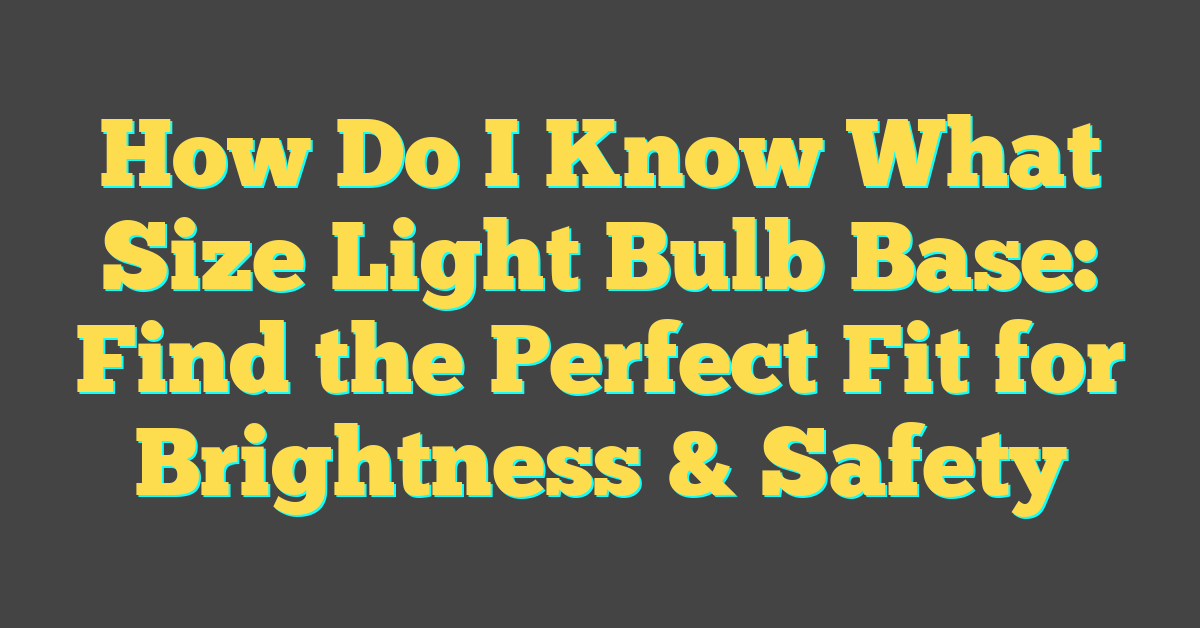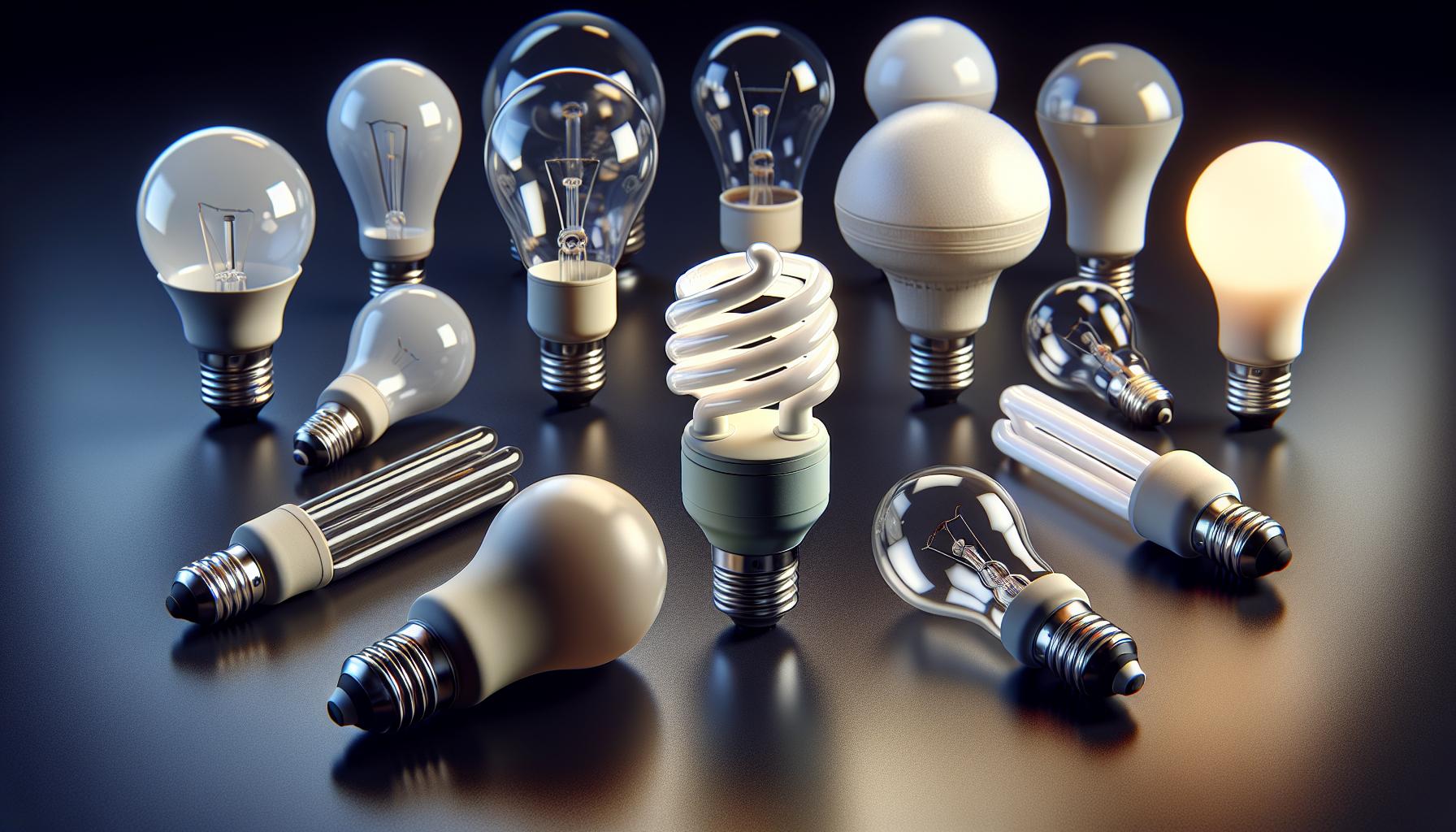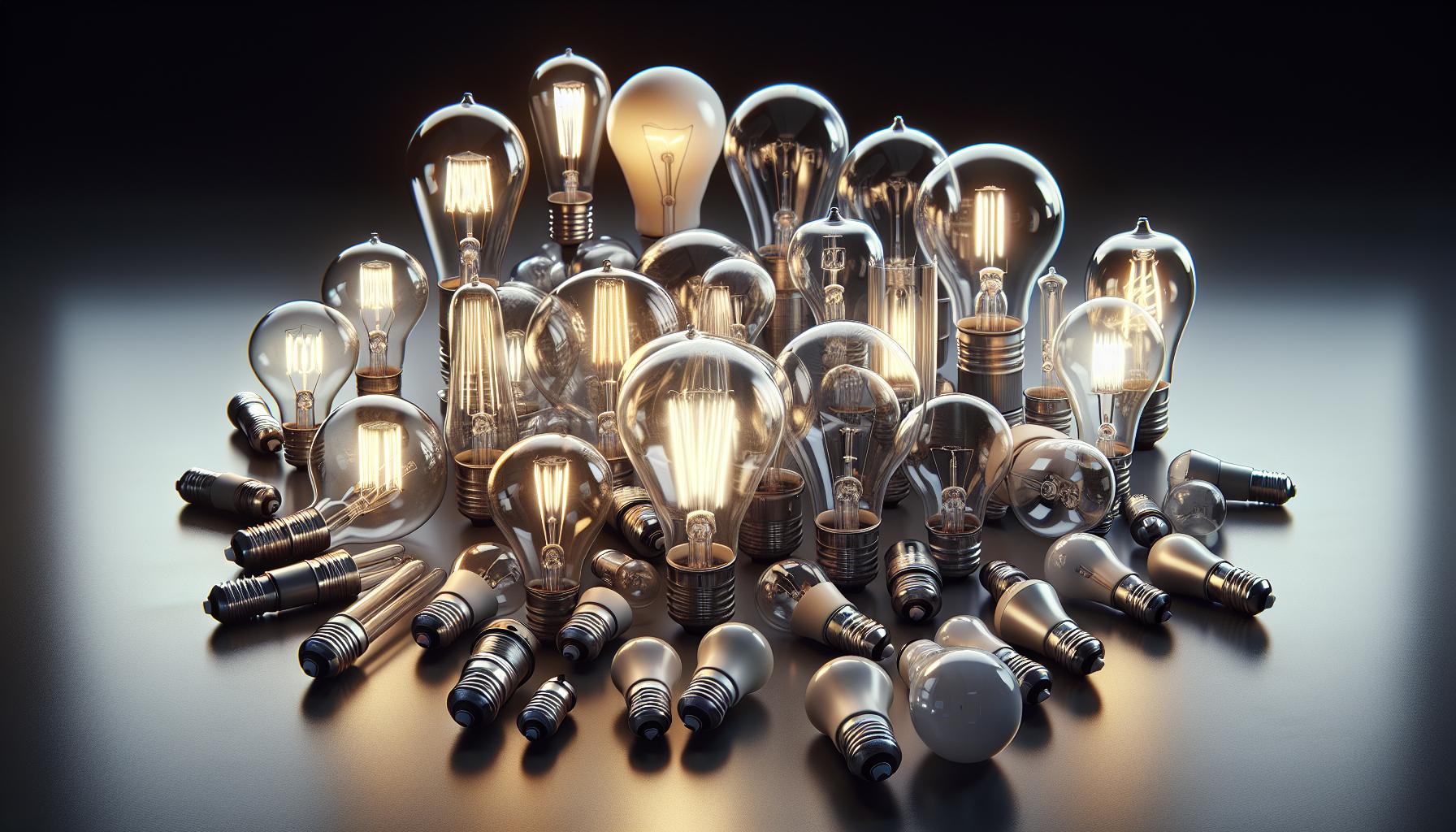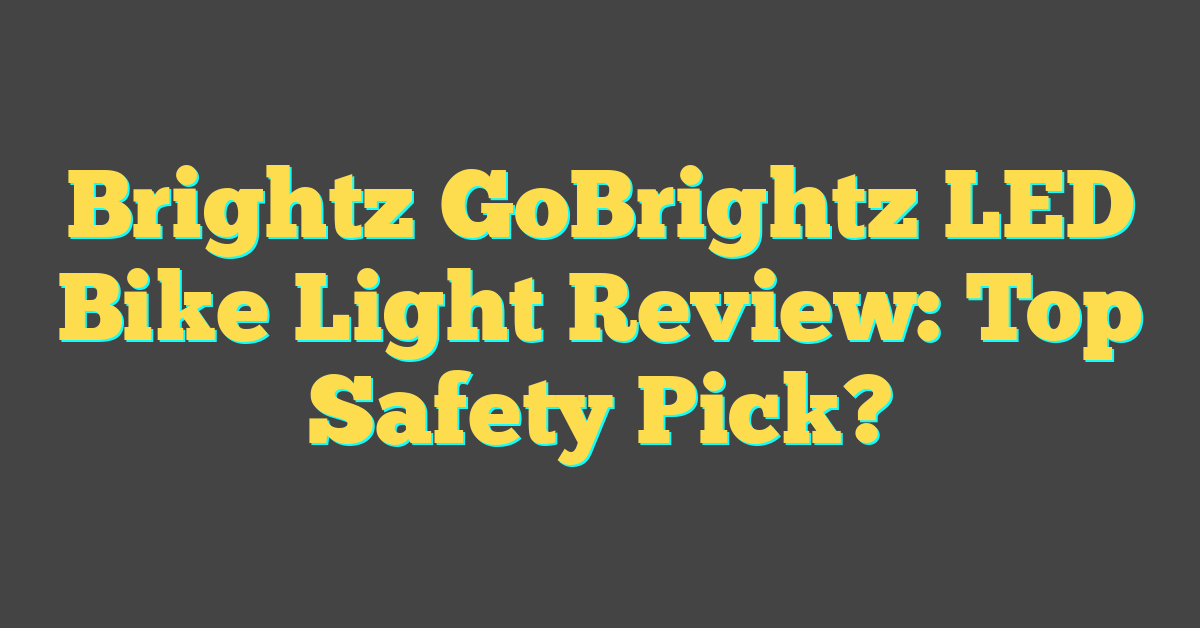Ever found yourself staring at a bewildering array of light bulbs at the store, wondering which one will fit your lamp at home? You’re not alone. Knowing the size of the light bulb base you need is crucial, but it’s often overlooked until you’re in the aisle scratching your head.

Don’t worry, figuring out the right base size isn’t rocket science. It’s all about matching letters and numbers—a code that’ll make you a light bulb shopping pro in no time. Let’s shed some light on how to crack this code so you’ll never second-guess your light bulb base size again.
Why Knowing the Light Bulb Base Size is Important
When you’re knee-deep in a DIY lighting project, you’ll appreciate the true value of matching the correct light bulb base size with your fixtures. It’s not just about the satisfaction of a job well done; it’s about the functionality and safety of your lighting solutions.
Firstly, the base size of your bulb ensures a secure fit into the fixture. If you’ve ever experienced the frustration of a loose bulb—or worse, one that won’t fit at all—you’ll understand why this is crucial. The right fit prevents electrical hazards such as short circuits, which can occur when a small base bulb rattles around in a large socket.
Moreover, with energy efficiency at the forefront of home projects, knowing your bulb base size supports environmental responsibility. Imagine purchasing an energy-saving LED bulb only to discover it doesn’t fit your fixture. Not only is this a waste of money, but it can also mean a missed opportunity to reduce your carbon footprint.
Finally, becoming savvy with light bulb base sizes elevates your DIY capabilities. You’ll find yourself quickly identifying what you need and accomplishing tasks with increased confidence. Plus, when you know your bulb bases, you open the door to a wider world of lighting options—vintage Edison bulbs for that retro look or smart bulbs for high-tech home integration.
To avoid the annoyance of multiple trips to the store, take a moment before you shop to check the base code of your current bulbs or fixtures. Keep a handy record for future reference and remember, a little knowledge in this area goes a long way in ensuring your lighting projects shine bright.
Understanding Light Bulb Base Sizes

When you’re knee-deep in DIY projects, the last thing you want is a hiccup with something as simple as a light bulb base. Light bulb bases come in various sizes, generally categorized by a series of letters and numbers. This code not only represents the shape and size but also the pin configuration of a bulb’s base.
The most common base size for household bulbs is the E26, which refers to an Edison screw of 26mm in diameter. It’s what you’ll find on your standard A19 bulb. But if you’ve got smaller fixtures or decorative lights, you might encounter an E12 base, which is noticeably slimmer.
Here’s a quick guide to help you decipher these codes:
- E stands for Edison, the most common screw type
- GU indicates a bi-pin base type used for some halogen or LED bulbs
- MR means the bulb is multifaceted reflector, commonly found in track lighting
In addition to matching sizes, it’s essential to note that using the right base affects your light bulb’s lifespan and your home’s energy efficiency. Incorrect base size can lead to poor connections, flickering lights, or even damage to your light fixture. This is especially critical with the rise of smart bulbs, which come with their own set of specifications and capabilities.
To ensure you’ve got the right fit:
- Check your light fixture or the base of your existing bulb for the base code.
- Measure the base diameter if you’re unsure.
- Reference a light bulb base chart or your local hardware store for additional guidance.
Arming yourself with knowledge about light bulb bases is more than a practical move—it empowers you to tailor the ambiance of your space to your specific taste without running into compatibility issues. Stick to these tips, and your home lighting projects will shine smoothly, one bulb at a time.
Decoding the Code: Letters and Numbers

« Why Did My Light Bulb Explode When Switched On? Uncover Shocking Reasons Now
Are Light Bulbs Ohmic? Unveiling the Shocking Truth About Your Home Lighting »
So you’re staring at this mysterious code on your light bulb and wondering what kind of secret language it’s speaking. Don’t worry; you’re about to crack the code. When you see a letter at the beginning of your bulb’s base code, it’s telling you the shape of the base. For example, ‘E’ stands for Edison, the most common screw-in type base. It’s your go-to guy for many of the bulbs around your home.
Brace yourself for the numbers that follow these letters. These aren’t random digits; they’re actually indicating the diameter of the base. It’s typically measured in millimeters, so when you see an E26, that’s an Edison screw with a diameter of 26 millimeters. Easy, right?
Let’s break it down:
- E is for Edison, your classic screw-in base.
- G goes for globe-shaped pins or bi-pin bases.
- B denotes bayonet, seen in many UK lighting fixtures.
Remember, when you’re tackling DIY home projects, knowing your bulb’s base size is half the battle. With this knowledge, you’ll feel like a lighting pro who can illuminate the darkest corners without so much as a flicker of doubt.
To give you a clear example, let’s visualize some common base codes:
| Code | Meaning |
|---|---|
| E26 | Edison screw with a 26mm diameter |
| E12 | Edison screw with a 12mm diameter |
| G4 | Bi-pin base with 4mm between pins |
| B22 | Bayonet base with 22mm diameter |
With these insights, you’re well on your way to tackling any lighting project that comes your way. Just remember to measure twice and purchase once. Now, off you go to find that perfect bulb—no guesswork needed.
Common Light Bulb Base Sizes

When it’s time to pick out a new bulb for your home, you’ll find a variety of base sizes to match any fixture. Understanding the most common base sizes can save you from the frustration of a mismatched bulb.
E26 bases, sometimes referred to as “medium” bases, are arguably the most prevalent in North America. Your standard table lamp, floor lamp, and most ceiling fixtures typically use an E26 base light bulb.
For smaller lamps or fixtures, you’ll likely need an E12 base, known commonly as the “candelabra” base. These are significantly narrower than their E26 counterparts. Decorative and elegant, E12 bases are a staple in chandeliers and ornamental light fixtures.
In Europe and other regions, the E27 and E14 are the equivalents to E26 and E12, respectively, with a slight difference in voltage requirements – something you’ll need to consider if you’re dealing with imported fixtures or bulbs.
GU10 bases are different – they lock into place with a twist-and-lock mechanism. You’ll find these primarily in track lighting or certain types of recessed lights.
If you’ve got halogen spotlights or certain types of desk lamps, then you’re likely handling a G4 base, which consists of two pins spaced 4mm apart. These are low-voltage light bulbs often found in under-cabinet lighting or decorative fixtures.
| Base Code | Common Name | Typical Use |
|---|---|---|
| E26 | Medium Base | Table Lamps, Ceiling Fixtures |
| E12 | Candelabra Base | Small Lamps, Chandeliers |
| E27 | European Medium Base | Imported Fixtures, Specialty Lamps |
| E14 | European Small Base | Imported Decorative Lighting |
| GU10 | Twist-and-Lock Base | Track Lighting, Recessed Lights |
| G4 | Bi-pin Base | Halogen Spotlights, Desk Lamps |
Tips for Finding the Right Light Bulb Base Size

When choosing a light bulb base, you’re not just selecting a product—you’re ensuring the safety and brightness of your space. Let’s dive into some savvy tips for picking out the perfect fit for your fixtures.
Measure Twice, Purchase Once
Before you head out to buy a bulb, grab a ruler or a caliper and measure your fixture’s socket. Light bulb bases are not one-size-fits-all, and assuming can lead you down a dimly lit path. If you’re replacing a bulb, measure the base of the old one or note down the base code from its label.
Check Your Fixture’s Specifications
Often, lamps and fixtures come with a user manual or a sticker indicating the appropriate bulb base size and shape. Look for these hints—they’re like the fixture whispering in your ear, guiding you to the right choice.
Bring an Old Bulb with You
If you’re unsure about the size or type, bring the old bulb as a reference when you shop. Retail associates at the hardware store can help you match it to a new one, eliminating the guesswork.
- Match the Code
- Remember to match the code you’ve noted with the available bulbs. A mismatched base won’t just be a hassle—it won’t thread or connect, leaving you lightless.
Consider the Lamp’s Design
Does your lamp have a narrow neck or a small shade? Certain base sizes can be too wide or bulky. The aesthetic component of your lighting is just as important as the functional aspect. Look for bulb bases that complement the design as well as fit physically.
Beware of Knock-Offs
Lower-priced, no-name brands might tempt you with bargain tags, but they often fall short in quality and longevity. Stick to reputable manufacturers for consistency in sizing and better overall performance.
Diving into the world of lighting needn’t leave you in the dark. With these practical steps, you’ll illuminate your home with ease and confidence, knowing you’ve got the perfect bulb base for your space. Remember, it’s not just about filling a socket—it’s about creating a bright and safe environment for you and your loved ones.
Conclusion
You’ve got all the tools you need to ensure you pick the right light bulb base for your space. Remember, it’s not just about the brightness; it’s about creating a safe, well-lit environment that suits your needs. Trust your measurements, stick with what you know, and don’t be tempted by those cheaper alternatives that could cost you more in the long run. With the right base, you’ll light up your space perfectly. Happy illuminating!
Frequently Asked Questions
What is the first step in finding the right light bulb base size?
The first step is to measure your fixture’s socket or to check the fixture’s specifications for the correct base size.
Can I use an old bulb as a reference when shopping for a new one?
Yes, bringing an old bulb as a reference when shopping can help you find the correct base size for your light fixture.
Why is it important to match the base code on a light bulb?
Matching the base code is crucial to ensure that the bulb fits securely in the socket of your fixture and operates safely and effectively.
How does the design of the lamp affect my light bulb base choice?
The design of your lamp can dictate the size and type of base required, so it is important to consider the lamp’s design when choosing a bulb.
Is it okay to buy lower-priced, no-name brand light bulbs?
It’s generally advisable to avoid lower-priced, no-name brands as they may compromise on safety and quality. Stick to reputable manufacturers for the best results.
What are the consequences of selecting the wrong light bulb base?
Choosing the wrong light bulb base can lead to poor fit, reduced efficiency, safety issues, and the possibility of damage to the socket or fixture.




